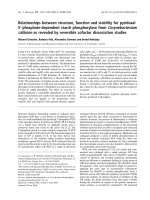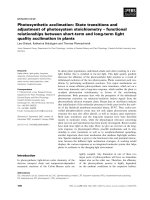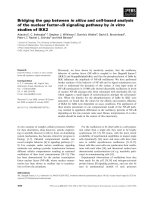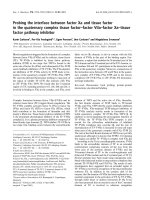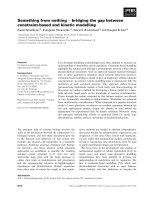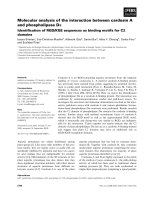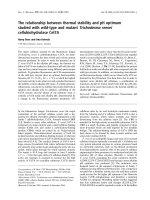Investigating the relationships between intrinsic motives and willingness to contribute knowledge to close and distant colleagues
Bạn đang xem bản rút gọn của tài liệu. Xem và tải ngay bản đầy đủ của tài liệu tại đây (1.15 MB, 216 trang )
INVESTIGATING THE RELATIONSHIPS BETWEEN INTRINSIC
MOTIVES AND WILLINGNESS TO CONTRIBUTE KNOWLEDGE
TO CLOSE AND DISTANT COLLEAGUES
FOONG HING WIH, AWIE
NATIONAL UNIVERSITY OF SINGAPORE
2009
INVESTIGATING THE RELATIONSHIPS BETWEEN INTRINSIC
MOTIVES AND WILLINGNESS TO CONTRIBUTE KNOWLEDGE
TO CLOSE AND DISTANT COLLEAGUES
FOONG HING WIH, AWIE
(B.Eng. (Hons), University Technology of Malaysia)
A THESIS SUBMITTED FOR THE DEGREE OF DOCTOR OF PHILOSOPHY
DEPARTMENT OF INDUSTRIAL & SYSTEMS ENGINEERING
NATIONAL UNIVERSITY OF SINGAPORE
2009
ACKNOWLEDGMENTS
I am indebted to the helps of many people in this long, and sometimes winding, journey of my study.
Especially, I would like to first thank the faculties and colleagues in the National University of
Singapore. I am deeply grateful to the generous support from the Department of Industrial System and
Engineering.
Particularly, I am indebted to my supervisors Dr. Chai Kah-Hin and Dr. Yap Chee-Meng for their
guidance and advice throughout this journey. I have learnt a great deal from both of you. Dr. Yap
teaches me research fundamentals, without which the thesis will fall. Dr. Chai gives life to the thesis,
is always full of ideas, and at the same time extremely caring and understanding. But most
importantly, their trust and patience in me are the greatest motivations that urge me to carry on and
not giving up.
To my fellow colleagues in ISE department, thanks for being such great teachers and friends. Just to
name a few: Darrel, Hongling, Kanshu, Kok-Beng, Linjun, Renyu, Wangqi, Xiaokong, Xiaoyang,
Xinyan, Yudan, Yufeng, Zhoupeng, and many more.
A special thanks to Dr. Wendelien van Eerde. I enjoy her class so much that it actually changes my
research direction, and she is always willing to listen to me and read my papers.
The experience that I have gained in my PhD study is not something that money can buy. I have learnt
tremendously, both academically and personally. I have enjoyed the classes and what I must call the
world-class supports provided by the university. Also not forgetting the sports competitions where
laughter is exchanged and friendships are won.
Last but not least, none of this will happen without the love and support from my dear wife Supei, my
best friend and partner in life. The six long years of PhD journey is truly a testament to our
commitment. Words can never express the feeling that is deep in my heart. Of course, the supports
from all our families; the understandings and acceptance, the encouragement and hope, this journey is
more meaningful because of you.
Thank you everyone.
Awie H.W. Foong
October 2009
i
TABLE OF CONTENTS
Acknowledgements i
Table of Contents ii
Summary vi
List of Tables vii
List of Figures viii
Chapter 1 Introduction 1
1.1 Motivation of the Study 1
1.2 Research Gaps and Objectives 2
1.3 Theoretical Model 6
1.4 Expected Research Implications 8
1.5 Thesis Outline 10
Chapter 2 Literature Review 12
2.1 A Brief Overview of Organizational Learning and Knowledge
Management Literature
12
2.2 Motivation to Contribute Knowledge 16
2.2.1 Knowledge-based View of the Firm 17
2.2.2 Motivation Factors for Knowledge Contribution 23
(a) Economic Factors 24
(b) Social Factors 26
(c) Personal or Intrinsic Factors 30
2.3 Research Gap 32
2.3.1 Research Gap-1: Contradiction Between Theoretical
Assumptions and Empirical Findings about Human
Motivation
33
2.3.2 Research Gap-2: Interactions Between Personal and
Situational Factors
37
2.3.3 Research Gap-3: Differences Between Knowledge-
Contribution Motivation to Close and Distant Colleagues
40
2.4 Summary 43
Chapter 3 Theoretical Model and Hypotheses Development 45
3.1 Addressing Research Gap-1: The Contents Theories of Motivation 45
3.1.1 Philosophical Perspective of Human Nature 45
3.1.2 The Contents Theories of Motivation 46
3.1.3 The Sensitivity Theory 51
ii
3.1.4 Conception of Intrinsic Motives 52
3.1.5 Conception of Intrinsic Motivation 54
3.2 Addressing Research Gap-2: The Process Theories of Motivation 61
3.2.1 Interactional Psychology and Functional Approach to
Motivation
61
3.2.2 Means-Ends Analysis of Motivated Behavior 62
3.2.3 Research Model: Integrating the Functional Approach and
Intrinsic Motives
64
3.3 Operationalization of Research Model 67
3.4 Addressing Research Gap-3: Analysis of the Gaps Between
Knowledge-Contribution Motivation to Close and Distant
Colleagues
69
3.5 Hypotheses Development 73
3.5.1 Acceptance Motive (ACM) 74
3.5.2 Honor Motive (HNM) 77
3.5.3 Power Motive (PWM) 81
3.5.4 Status Motive (STM) 83
3.5.5 Vengeance Motive (VGM) 85
3.5.6 Citizenship Motive (CTM) 88
3.5.7 Social Contact Motive (SCM) 90
3.6 Summary 91
Chapter 4 Research Methods 94
4.1 Overview 94
4.2 Interviews with Practitioners 95
4.3 Development of Survey Instrument 96
4.3.1 Items Development 96
(a) Dependent Variable: Willingness to Contribute
Knowledge
97
(b) Control Variables 98
(c) Situational Variables 101
(d) Intrinsic Motives 105
4.3.2 Pilot Survey – Pretest of Questionnaire 106
4.4 Sampling and Data Collection 107
4.5 Summary 110
Chapter 5 Analysis and Results 111
5.1 Psychometric Properties 111
5.2 Common Method Bias 113
5.3 Regression Models 117
iii
5.4 Regression Analysis and Results 118
5.4.1 Inter-Construct Correlations 118
5.4.2 Overall Model Validity 123
5.4.3 Hypotheses Testing 124
(a) Acceptance Motive 124
(b) Honor Motive 127
(c) Power Motive 128
(d) Status Motive 129
(e) Vengeance Motive 130
(f) Citizenship Motive 133
(g) Social Contact Motive 135
(h) Control Variables 135
5.4 Summary 137
Chapter 6 Discussion, Implications and Conclusion 139
6.1 Discussion 139
6.1.1 Research Gap-1: The lack of a unifying theoretical model
for knowledge-contribution motivation
139
6.1.2 Research Gap-2: The lack of understanding on the
interaction between personal and situational factors
140
6.1.3 Research Gap-3: The lack of understanding on the factors
that lead to discrimination for or against close or distant
colleagues
142
6.2 Research Implications 143
6.2.1 Theoretical Implications 144
6.2.2 Methodological Implications 149
6.2.3 Practical Implications 149
(a) Hiring and Selection 153
(b) Internal Communication 153
(c) Reward and Recognition 155
(d) Job Design 156
(e) Learning and Development 156
(f) Knowledge Sharing Tools 157
6.3 Limitations and Future Research Directions 158
6.4 Conclusion 163
References 166
Appendices 185
Appendix A Questionnaire 185
iv
Appendix B Summary of Reliability and Validity of Reiss Motivation Profile of 16
Basic Desires
192
Appendix C Exploratory Factor Analysis for Pilot Survey 194
Appendix D Exploratory Factor Analysis for Main Survey 197
Appendix E Inter-constructs Correlations and AVE in PLS 200
Appendix F Items Cross Loadings in PLS 201
Appendix G Mediation Analysis between Recognition (REC), Knowledge Efficacy
(VAL), and Willingness to Contribute Knowledge (WTC)
205
v
SUMMARY
This study aims to address one of the most vital managerial challenges to the modern day
knowledge intensive organization: the challenge to encourage and induce knowledge contribution
behaviors among the knowledge workers. It follows the functional approach to motivation and
subscribes to a multifaceted conception of intrinsic motives in order to examine the combined
effects of personal and situational factors on employees’ motivation to contribute knowledge. The
study also explores the similarities and differences in the motivation to contribute knowledge to
the close and distant colleagues. Data is collected from a cross sectional survey of 235
professional workers in Singapore and Malaysia. Results from the moderated multiple regressions
provide encouraging support to the proposed framework. The results show that knowledge-
contribution motivation is affected by both the situational and personal factors, as well as the
interactions between the two. Furthermore, employees contribute or withhold knowledge from
their close and distant colleagues for different reasons. This study contributes to the knowledge
management research by providing a theoretical basis for the integration of previously
contradictory assumptions about intrinsic motivation and human nature. It also contributes to the
HRM research and practice by highlighting the issues of individual differences in knowledge-
contribution motivation. The findings suggest that a proper diagnosis of the intrinsic motives of
individual employees is critical to the management of knowledge-contribution motivation, and
that the motivation to contribute knowledge can be enhanced with a strategy of maximizing the
fulfillment of intrinsic motives through knowledge contribution.
Keywords: Knowledge-Contribution Motivation; Intrinsic Motives; Basic Needs, Functional
Approach to Motivation; Knowledge-based View of the Firms, Human Resource Management
vi
LIST OF TABLES
Table 2-1 A Summary of Empirical Studies on Knowledge-Contribution Motivation
at the Individual Level of Analysis
23
Table 2-2 Summary of Research Gaps and Questions 44
Table 3-1 Reiss’s Profile of 16 Fundamental Motives 49
Table 3-2 Summary of the Four Major Needs Theories 50
Table 3-3 Descriptions of the ‘Discrepancy’ Constructs 72
Table 3-4 Mapping the Intrinsic Motives to the Findings from Past Studies 74
Table 3-5 Summary of Research Questions, Gaps and Hypotheses 92
Table 4-1: Summary of Responses to Q10 95
Table 4-2 Survey Items for Willingness to Contribute Knowledge 98
Table 4-3 Survey Items for Knowledge Self-Efficacy (Perceived Value of
Knowledge)
99
Table 4-4 Survey Items for Rewards Contingency 99
Table 4-5 Survey Items for Time Pressure 100
Table 4-6 Survey Items for Personal Resources Consumption 100
Table 4-7 Survey Items for Task Interdependence 102
Table 4-8 Survey Items for Rewards Competition 102
Table 4-9 Survey Items for Expert Status Recognition 103
Table 4-10 Survey Items for Knowledge Sharing Norm 104
Table 4-11 Survey Items for Reciprocity Norm 104
Table 4-12 Survey Items for Intrinsic Motives 105
Table 4-13 Demographic Information of Respondents 109
Table 5-1 Overall Correlation Matrix 115
Table 5-2 Summary of Descriptive Statistics 119
Table 5-3(a) Summary of Regression Outputs for Close Model 120
Table 5-3(b) Summary of Regression Outputs for Distant Model 121
Table 5-3(c) Summary of Regression Outputs for Delta Model 122
Table 5-4 Summary of Hypotheses Testing and Key Findings 138
vii
LIST OF FIGURES
Figure 1-1 Development of the Research Model 7
Figure 2-1 The Outcomes of Knowledge Sharing Motivation 15
Figure 3-1 Functional approach to knowledge-contribution motivation 67
Figure 3-2 Operationalization of the Research Model: Hierarchical Moderated
Multiple Regression Model
69
Figure 4-1 Overview of the Research Process 94
Figure 5-1 Correlation between Acceptance Motive and Willingness to Contribute
Knowledge
125
Figure 5-2 Interaction between Acceptance Motive and Social Pressure (Distant
Model)
126
Figure 5-3 Interaction between Honor Motive and Knowledge Sharing Norm 127
Figure 5-4 Interaction between Honor Motive and Interdependence (Close Model) 128
Figure 5-5
Interaction between Status Motive and ∆INDP
130
Figure 5-6 Correlation between Vengeance Motive and Willingness to Contribute
Knowledge
131
Figure 5-7 Interaction between Vengeance Motive and Reciprocity Norm 132
Figure 5-8
Interaction between Vengeance Motive and ∆INDP
133
Figure 5-9 Interaction between Citizenship Motive and Reciprocity Norm 134
Figure 6-1 HR Practices as Governing Mechanisms for Enhancing Knowledge
Contribution-Motivation
152
viii
CHAPTER 1 INTRODUCTION
1.1 Motivation of the Study
In today’s knowledge intensive economy, organizations that are capable of learning and
transferring knowledge faster than their competitors will enjoy more competitive advantage than their
competitors (Argote & Ingram 2000; Foss 2007; Grant 1996; Spender 1996). Jerry Junkins, former
president and CEO of Texas Instrument once lamented the lack of knowledge sharing in his company:
“If we only knew what we know at TI…”, implying the potential savings and additional revenues that
could have been realized if internal know-how and best practices are being shared more effectively
across the organization.
Success stories from organizations like Xerox and British Petroleum (now BP Amoco) have
inspired many knowledge-intensive organizations to emulate their success. IN BP, for instance, their
knowledge sharing initiatives have brought substantial tangible benefits to the company’s bottom line
(Prokesch 1997). One example is an investment of a quarter million-dollar on knowledge sharing among
the staffs of the refinery business units. The return-on-investment attributed to these initiatives is
estimated to be over forty times (Milton 2007). At the Nerefco refinery alone, the benefit was estimated
at $9.6 million. In fact, according to one calculation, the overall business benefits attributed to
knowledge management initiatives across the organization, from refinery turnarounds to the
construction of retail sites, business restructuring and new oil and gas field development was an
astonishing $260 million! (SAIC corporate website, />It is not a surprise that, despite the conceptual ambiguity (Alavi & Leidner 2001; Binney 2001;
Garvin 1993; Jones 1995; Quintas, Lefere & Jones 1997; Schultze & Leidner 2002; Wilson 2002) and
1
practical difficulties (Gupta, Iyer & Aronson 2000; McDermott 1999; Riegel 2005) associated with
organizational learning and knowledge management, the potential benefits from knowledge sharing
have encouraged organizations around the world to continue investing heavily in knowledge sharing
tools and practices (Hansen, Nohria & Tierney 1999; Ngai & Chan 2005; Storey & Barnett 2000).
In order to create and transfer organizational knowledge effectively, organizations have to rely
on the knowledge sharing from its very original source, i.e. the individuals (Huber 1991; Kim 1993;
Nickerson & Zenger 2004; Nonaka 1994). Very little knowledge sharing will take place without
voluntary contribution from the knowledge source (Hayek 1945; Kim & Mauborgne 1998). Studies
from both industrial and academic institutions have pointed to the difficulties in getting people to share
knowledge at work (e.g. Ardichvili, Page, Wentling 2003; Gammelgaard 2004; King, Marks, McCoy
2002; KM Review Editorial 2001; KPMG 1999; Ruggles 1998).
As such, this study aims to improve the understanding of the fundamental reasons that underlie
individual motivation to contribute or withhold knowledge at work. Organizations that have better
understanding in these motivational issues would be able to manage knowledge sharing more effectively
and efficiently than their competitors, e.g. by hiring the right people for the right jobs, implementing
more appropriate HR practices or governing mechanisms, and investing in the right tools to facilitate
knowledge sharing.
1.2 Research Focus, Gaps and Objectives
Imagine a workplace where knowledge is not shared: Workers do not talk about things that they
learn, important information they obtained within or outside the workplace, their problem solving
experience or other work experiences. Everyone is left to find their own way to the knowledge they
need in order to perform their job duties. It is probably still possible for the organization to function, but
2
the operations will be extremely inefficient. The same mistakes will be repeated over and again by
different people. When individual employees do not share what they know with others, knowledge will
not be disseminated, and consequently organizations will not learn.
Fortunately, this is not the typical scenario that you will find in a work organization. The more
likely scenario is that knowledge is being shared throughout the organization, but in a non-symmetrical
way. Some business units would tend to have more knowledge sharing than others (Edmondson 1999);
and some individuals are more willing to share than others (Mooradian Renzl & Matzler 2006).
Research in social networks also finds that individuals tend to put more effort in sharing knowledge
with colleagues with stronger ties than weaker ties (Hansen 1999; Levin & Cross 2004).
There are good reasons why some people are always more willing to share than others, why
some situations are more conducive to knowledge sharing, and why some recipients are preferred over
the others. Answers to these asymmetrical knowledge sharing phenomena lie in the various factors that
motivate a person to contribute knowledge to others in the workplace.
Knowledge sharing generally refers to both the give (contribution) and take (reception) of
knowledge. In this study, knowledge contribution is conceptualized as an interaction between the
knowledge source and the knowledge seekers or the work environment or both. A person may contribute
his/her knowledge to other persons or to certain knowledge repository tools or systems. As such, the
personal characteristics of the knowledge source and his /her perceptions about the knowledge seekers
or recipients and the work environment are expected to be the key determinants of knowledge-
contribution motivation.
This study focuses on the behavioral intention of knowledge contribution at work (e.g. Bock,
Zmud, Kim & Lee 2005) instead of the actual knowledge transfer that takes place (e.g. Szulanski 1996;
3
Ko, Kirsch & King 2005)
1
. By focusing on the behavioral intention of knowledge contribution, this
study is particularly significant to knowledge-based organizations because the intention to contribute
something valuable such as personal knowledge can also be seen as a form of organizational citizenship
behavior, which signifies the employees’ willingness to contribute over and above their contractual
obligations (Organ 1997; Williams & Anderson 1991).
Motivation to share knowledge covers a number of broad issues, and this study is unable to
cover all those aspects. Instead, this study focuses on three specific research gaps. The research gaps are
drawn from a variety of management and psychology literature: knowledge management, organizational
learning, strategic management, motivation theories, personality and social psychology etc. The overall
objective of this study is to address these three gaps in a systematic and rigorous manner.
The first research gap is concerned with the implicit assumption about the nature of human
motivation. The underlying question is: what motivates a person to contribute knowledge at work?
Current theorization of knowledge-contribution motivation is divided by three prominent but competing
assumptions about human nature. The economic exchange perspective views human nature as inherently
opportunistic and that people act to fulfill their self-interest (Williamson 1985). The social exchange
perspective assumes a universal desire of social belongingness that explains people’s tendency to
conform to social norms (Blau 1960). Finally, the eudemonic-based intrinsic motivation perspective
assumes that human is naturally endowed with three innate psychological needs, i.e. competence,
autonomy, and relatedness (Deci & Ryan 1985).
However, empirical evidence from studies related to knowledge-contribution motivation
1
In this study, there are a number of reasons that prompted me to choose behavioral intention, rather than behavior, as
the dependent variable: (a)Knowledge contribution behavior can be a ‘noisy’ construct to measure. Knowledge
contribution behavior can be affected by factors other than motivation, such as real time constraints, information
confidentiality, and competition with other work activities. Particularly, the actual knowledge transfer would also be
affected by knowledge-related factors and communication-related factors (Ko et al 2005, Szulanski 1996);
(b)According to the Theory of Reasoned Action, behavioral intention is a good predictor to behavior (Ajzen, 1991).
Considering the above, I feel that it is appropriate to operationalize motivation as behavioral intention in the context
of this study.
4
suggests that human nature may be more multifaceted in nature. Furthermore, the individuality of
knowledge workers, i.e. the role of individual knowledge workers, is becoming more prominent in a
knowledge economy than in the past (Miles, Snow & Matthews 1997). Therefore, the individual
differences among knowledge workers should warrant more attention in management studies going
forward. Hence, the first objective of the study is to address the contradictions from these three
assumptions about human nature and to propose a theoretical framework that integrates those
assumptions.
The second research gap stems from the view of interaction psychology about human motivation
(Terborg 1981). Literature in organizational behavior and human resource management has a general
consensus that both person and situation effects are important determinants of employee behaviors
(Kahn 1990). Interaction psychology suggests that people behave differently under different situations
(Bowen & Ostroff 2004; Endler & Magnusson 1976), and that situational factors may affect different
people to different extents (Clary, Snyder & Ridge 1998; Snyder 1993).
In the field of knowledge management, however, the application of interaction psychology in
understanding knowledge-related behaviors is still at a very early stage (Foss 2007). Especially, the
knowledge management literature has not considered how the situational factors such as the perceptions
about work conditions, social norms, or the knowledge seekers may affect knowledge sharing behavior
of different people differently. Therefore, the second objective of this study is to provide a more refined
understanding about knowledge sharing motivation by taking an interaction approach so that the
interactions between personal and situational factors can be better understood.
The third research gap is related to the network ties theories put forth by Granovetter (1973,
1983) and Burt (1997). The theories of network ties is important in the studies of knowledge sharing
because the identities and interpersonal relationships between the knowledge contributor and recipients
5
are important determinants to the willingness to share and the quality of knowledge that is being shared
(Levin & Cross 2004; Szulanski 1996, 2000).
Past studies have shown that closer network ties facilitate the sharing of complex knowledge
because the relationships between the source and the recipients are less arduous and more intimate
(Szulanski 1996). Complex knowledge is usually more tacit in nature, and therefore requires a great deal
of efforts to explicate or elicit before the knowledge can be transferred to the recipients (Hansen 1999).
On the other hand, weak network ties also hold certain unique values in that it allows for wider reach to
non-redundant information and therefore provide novel information that cannot be found within the
strong ties (Levin & Cross 2004).
In a typical work organization, strong ties usually exist among the close colleagues; whereas the
distant colleagues usually have weaker ties. The reasons for an employee to contribute knowledge to the
close colleagues, i.e. those with stronger work ties, may be similar or different from the reasons to share
with the distant colleagues, i.e. those with weaker work ties. Although both strong and weak ties are
important for transferring different types of knowledge, and most organizations need both, an extensive
review of relevant literature has not found any study that explicitly address the similarities and
differences in the motivation to share knowledge with the strong and weak ties. The third research
objective is therefore aimed at addressing this gap. Understanding how to motivate employees to
contribute knowledge to their close and distant colleagues will allow organizations to optimize the
knowledge sharing at work.
1.3 Theoretical Model
An alternative research model is developed to address these three gaps. The schematic
representation of the research model is shown in Figure 1-1.
6
Figure 1-1 Development of the Research Model
In order to address Research Gap-1, I use the concept of individual differences and subscribe to
the multifaceted conception of intrinsic motives from the sensitivity theory (Reiss 2000; 2004). The
concept of individual differences allows for the accommodation of different assumptions about human
nature; whereas the sensitivity theory and Reiss’s profile of sixteen intrinsic motives provide a
theoretical basis for the operationalization of the concept of individual differences.
The second research gap is addressed through a functional approach to motivation (Snyder
1993) which is grounded on the same logic as the expectancy-value model (Vroom 1964) and the path-
goal theory (Galbraith & Cummings 1967). The functional approach to motivation provides a good
logical explanation to the motivation process. A person is motivated to contribute knowledge either
intrinsically or extrinsically. Intrinsically motivated behavior is conceptualized as a direct fulfillment of
intrinsic motives. On the other hand, extrinsically motivated behavior is conceptualized as an indirect
fulfillment of intrinsic motives through the fulfillment of extrinsic motives, i.e. an action will lead to the
fulfillment of certain outcomes that are extrinsic to the action (e.g. getting a reward) and those outcomes
will then lead to the fulfillment of certain intrinsic motives. Under such circumstances, intrinsic motives
will interact with the extrinsic motives to affect a person’s motivation to engage in a particular behavior.
Contribute/
Withhold
Knowledge
To Close
Colleagues
To Distant
Colleagues
Fulfillment of
Intrinsic Motives
Research Gap-2
Research Gap-3
Research Gap-1
Fulfillment of
Extrinsic
Motives
7
The individual will assess the match-up between intrinsic motives and the situational factors and make
choices based on the likelihood of fulfilling the intrinsic motives that matter most to him/her.
To address the third research gap, I divide the model into two parts, by measuring the
employees’ willingness to contribute knowledge to their close and distant colleagues separately. In
addition, the discrepancies between the perceptions toward close and distant colleagues are compared
and analyzed to determine the factors that are associated to the discrimination for or against the close or
distant colleagues.
1.4 Expected Research Implications
This study is important to both the theorizing, as well as the managing of knowledge-
contribution motivation. From a theoretical perspective, the limitations of the current theorizations of
knowledge-contribution motivation, which are based on different assumptions about human nature, can
be resolved by subscribing to the interaction psychology approach to motivation and a multifaceted
view of intrinsic motivation. Both interaction psychology and the multifaceted view of intrinsic
motivation are new to the knowledge management field. The theoretical framework presented in this
study would allow for the integration, instead of substitution, of previously contradictory propositions
into a more comprehensive theoretical framework.
From the managerial point of view, this study may benefit managers in several ways. The
interaction approach to human motivation and a multifaceted view of intrinsic motivation help to
highlight the issue of individual differences and person-situation fit, which in turn shift the focus of
knowledge management from the traditional ICT-focused approach to an approach that focuses on
human factors.
8
The intrinsic motives profile of a person is distinctive and relatively stable during the adulthood
years. These inherent differences among different individuals could explain the natural tendency of a
person to contribute or withhold knowledge from others. Increasingly, the hiring and selection process
of key personnel should consider not just the skills and capabilities of the person, but also a broader set
of competencies which include personal attributes of the person. If knowledge sharing is a vital part of
the job, managers would need to know what to look for in order to select the right candidate for the right
job. This study provides a snapshot of correlations between knowledge-contribution motivation and the
different intrinsic motives. The theoretical model may help organizations to find out about the intrinsic
motives that matter most for their own contexts, and therefore provides better capabilities to identify and
select the most suitable candidates for a job.
Organization can encourage more knowledge sharing from the employees by modifying or
creating a work environment that it is conducive to knowledge sharing. However, doing so requires a
good understanding of the match-ups between the characteristics of the work environment and the
personal attributes of the employees. Very few studies have attempted to investigate knowledge sharing
motivation by considering the match-ups between organizational and personal characteristics and
recommend solutions that allow organization to understand what to do to motivate their current
employees. This study helps to connect the conditions for individual engagement in knowledge
contribution to the governing mechanisms or HR practices that managers can apply to induce the right
conditions.
The sharing of knowledge and information among close and distant colleagues can have
different but equally important implications to an organization. Knowledge sharing among close
colleagues enables the transfer of complex and rich tacit knowledge which allows the recipients to
shorten their learning curves and to retain important knowledge possess by the source. In other words,
important knowledge can be exploited more efficiently when knowledge is shared among the close
9
colleagues. On the other hand, knowledge sharing among distant colleagues often enables the recipients
to tap into the knowledge outside their own areas of expertise. This allows the recipients to explore
novel, non-redundant knowledge that is new to them and therefore helps to enhance innovation.
This study investigates the factors that affect knowledge-contribution motivation to close and
distant colleagues separately, and also examines the factors that lead to discrimination for or against the
close or distant colleagues. The findings help managers to understand the differences of knowledge
sharing motivation factors between close and distant colleagues and hence allow them to manage
knowledge sharing more effectively.
1.5 Thesis Outline
This thesis is organized as follow: First, a detailed review of the relevant literature in knowledge
management and knowledge-contribution motivation is provided in Chapter 2. The literature review
provides a description of the state-of-the-art of current research on knowledge-contribution motivation
and a critical review of the research gaps. Three research gaps are identified from the literature, and a
research question is framed for each research gap.
In Chapter 3, I present a detailed discussion for the development of the theoretical framework.
First, I provide a review of the motivation theories and propose an alternative theoretical framework,
using individual differences as the core concept, which integrates the three dominant assumptions about
human nature into a single framework. The theoretical framework is developed in three parts,
corresponding to the three research gaps identified in Chapter 2. Then, I discuss the hypotheses
development in detailed. Three sets of hypotheses are set forth to address the three research gaps.
Chapter 4 outlines the research methods. In this study, the primary data collection method is through
questionnaire survey. This chapter focuses on the development of survey instrument and the data
10
collection process. The results from the analysis of survey data are presented in Chapter 5. Finally,
Chapter 6 provides an overall discussion of the empirical findings and concludes with theoretical and
practical implications to issues related to knowledge-contribution motivation.
11
CHAPTER 2 LITERATURE REVIEW
The last couple of decades have witnessed a surge in studies on knowledge sharing in the
workplace. New research fields have emerged, most notably the fields of organizational learning (OL)
and knowledge management (KM). The attention on knowledge sharing has also being extended into
more established fields of studies, including strategic management and the theories of the firms (Conner
& Prahald 1996; Foss 2007; Grant 1996; Kogut & Zander 1996; Nahapiet & Ghosal 1998; Nickerson &
Zenger 2004; Spender 1996)., information systems management (Alavi & Leidner 2001; Kankanhalli,
Tan & Wei 2005); social network studies (Hansen 1999; Wasko & Faraj 2005) and human resource
management (Cabrera & Cabrera 2005; Minbaeva 2005). Questions remain, however, on the managerial
challenges to realize the potential benefits of knowledge sharing to the organization. Especially,
managers are facing an uphill task to encourage more knowledge sharing at work. This chapter provides
an extensive review of the existing studies related to knowledge sharing motivation.
2.1 A Brief Overview of Organizational Learning and Knowledge Management Literature
In a knowledge-based economy, knowledge is arguably one of the most important strategic
resources to the knowledge-intensive organizations. Especially, firm-specific knowledge allows the
organization to build sustainable competitive advantage due to the tacitness (Nonaka 1994) and
stickiness (Szulanski 1996) nature of such knowledge which prevents imitation from competing
organizations. An organization can build its sustainable competitive advantage through continuous
learning and creation of organizational knowledge.
Argyris (1977) proposes two types of organizational learning: single-loop and double-loop
learning. Single-loop learning refers to the detection and correction of error in operational routines
without questioning the assumptions that underlie the routines. Double-loop learning, on the other hand,
12
involves the questioning of the underlying assumptions, which is aimed at correcting the underlying
causes of error. Single-loop learning usually results in the improvement of operational routines, whereas
double-loop learning refers to the acquisition of dynamic capabilities or the learning of the capabilities
to learn. Zollo and Winter (2002) explain these concepts as follow: “These (organizational) learning
processes are responsible for the evolution in time of two sets of organizational activities: one geared
towards the operational functioning of the firm (both staff and line activities) which we will refer to as
operating routines; the other dedicated to the modification of operating routines, which is identified
with the notion of dynamic capabilities” (p.340, emphasis added).
Key to the concept of dynamic capabilities, according to Zollo and Winter (2002), is that
dynamic capabilities is systematically generated within the organization, implying deliberate
interventions in the pursue of the dynamic capabilities. This notion of deliberate learning and systematic
interventions tie the concept of dynamic capabilities to organizational governance mechanisms, i.e. the
acquisition, creation, transfer, and application of organizational knowledge can and should be
systematically governed.
Literature in organizational learning and knowledge management suggests that knowledge
sharing is the basis to the creation of organizational knowledge (Alavi and Leidner 2001; Crossan, Lane
& White 1999; Nonaka 1994). Knowledge sharing among individual knowledge workers is seen as the
key process that links individual learning to organizational learning (Kim 1993; Boland & Tenkasi 1995,
Crossan et al 1999). Weick and Roberts (1993) suggest that knowledge is given new meaning through
collective interpretation among the knowledge workers; whereas Nonaka (1994) and later Alavi and
Leidner (2001) argue that organizational knowledge is created through the sharing of individual
knowledge.
Knowledge sharing is generally defined as the provision of knowledge by the source and the
13
reception of knowledge by the recipient (Davenport & Prusak 1998), and generally involves two parties:
the knowledge source or contributor, and the knowledge recipient or learner (Szulanski 1996; Alavi &
Leidner 2001).
Building on the signaling metaphor (Shannon & Weaver 1949; Rogers 1994), Szulanski (1996,
2000) proposes a knowledge transfer model which consists of five key elements of the transfer process:
the characteristics of the knowledge source, the characteristics of the knowledge recipients, the
characteristics of the communication channel, the characteristics of the knowledge being transferred,
and the characteristics of the context where the knowledge transfer takes place. This generic knowledge
transfer model takes into account nearly all aspects of knowledge transfer. Ko et al (2005), for instance,
utilize this model to examine the knowledge transfer that takes place between ERP consultants and their
clients.
Some other studies that focus specifically on a specific element of knowledge transfer. These
include those that examine the tacit nature of knowledge (Nonaka 1994); the characteristics of the
knowledge seekers or recipients such as motivation to seek help (Lee 1997, 2002) and absorptive
capacity (Szulanski 1996); the characteristics of the contexts of transfer such as organizational culture
(McDermott & O’Dell 2001) and so on.
In this study, I have focused specifically on the knowledge source’s willingness to contribute
knowledge, i.e. examining the characteristics of the knowledge source, and how his/her perceptions
about the knowledge recipients and the contexts of knowledge sharing may affect his/her willingness to
contribute knowledge. Knowledge sharing generally includes both the give (contribution) and take
(reception) of knowledge; whereas knowledge contribution only refers to the contribution part.
Although both the motivation to contribute and receive knowledge is equally important, I would
14
argue that the factors pertaining to the knowledge source warrant more attention for the following
reasons: (1) Knowledge transfer would not take place if the source refuses to contribute his/her
knowledge to others. The learner needs to re-learn the knowledge that may already exist within the
organization, and this is costly to the organization; (2) Knowledge can still be codified and retained in
the knowledge repositories if the intended recipients are unwilling to accept the knowledge from the
source; and (3) Logically, the act of giving (contributing knowledge) should post greater cost than the
act of taking (receiving knowledge) and hence one should expect more obstacles in inducing knowledge
contribution behavior than knowledge reception behavior (see Figure 2-1).
Figure 2-1: The Outcomes of Knowledge Sharing Motivation
2
To sum up this section, the organizational learning and knowledge management literature
suggests that knowledge is the basis of organizational competitive advantage, and that knowledge
sharing is a precondition to organizational knowledge creation. Knowledge workers play the central role
in the sharing and creation of organizational knowledge; and the effectiveness of employee engagement
interventions is likely to be influenced by the organization’s governance mechanisms.
Questions remained, however, regarding the effectiveness of governing mechanisms to induce
knowledge sharing behavior at the individual level. To be sure, knowledge sharing is often an exception
2
Figure 2-1 is meant to show the combined effects of the willingness to contribute (source) and willingness to receive
(recipient) on knowledge transfer. It does not include the other elements of communication metaphor (knowledge-
related and communication-related factors) by Shannon and Weaver (1949), Szulanski (1996) and Ko et al (2005).
Knowledge can be codified
and retained in knowledge
repositories
No sharing
Active sharing and
collective learning
Relearning knowledge that
already exists
No
Yes
Yes
No
Is the Source Willing to Contribute?
Is the Recipient
Willing to
Learn?
15

